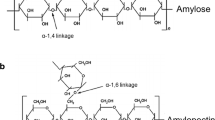Abstract
Effects of milling methods and organic acids treatments on rheological properties of rice flour were investigated. The average particle-size of wet-milled rice flour was lower and showed lower pasting temperature, peak viscosity, and storage modulus values than those of dry-milled rice flour. Wet-milled rice flour treated with citric acid showed significantly low viscosity and viscoelastic properties, as the concentration of citric acid increased, whereas wet-milled rice flour treated with acetic acid was not significantly affected by the acetic acid concentration. Rheological property of baekseolgi (Korean rice cake) made with wet-milled citric-acid-treated rice flour showed a similar trend in viscoelasticity, wherein citric acid treatment lowered the hardness of the rice. However, cohesiveness increased with increasing citric acid concentration. Overall, milling method affected the particle size, which influenced the viscosity and heat stability, whereas citric acid treatment affected the rheological properties of rice flour. These results are expected to contribute to the development of an appropriate method for rice flour application.
Similar content being viewed by others
References
Child NW. Production and utilization of rice. In: Rice Chemistry and Technology. Champagne ET (ed). American Association of Cereal Chemists, Inc., St. Paul, MN, USA. pp. 1–23 (2004)
Yang HS, Kim CS. Quality characteristics of rice noodles in Korean market. J. Korean Soc. Food Sci. Nutr. 39: 737–744 (2010)
Lee MK, Shin MS. Characteristics of rice flours prepared by moisture-heat treatment. Korean J. Food Cook. Sci. 22: 147–157 (2006)
Sciarini L, Ribotta P, Leon A, Perez G. Influence of gluten-free flours and their mixtures on batter properties and bread quality. Food Bioprocess Tech. 3: 577–585 (2010)
Kum JS. Nutrient of rice and rice processed products. Korean J. Food Preserv. 9: 38–54 (2010)
Lee MK, Kim JO, Shin MS. Properties of nonwaxy rice flours with different soaking time and particle sizes. Korean J. Food Sci. Technol. 36: 268–275 (2004)
Han HM, Cho JH, Koh BK. Effect of grinding method on flour quality in different rice cultivars. J. Korean Soc. Food Sci. Nutr. 41: 1596–1602 (2012)
We GJ, Lee IA, Kang TY, Min JH, Kang WS, Ko SH. Physicochemical properties of extruded rice flours and a wheat flour substitute for cookie application. Food Eng. Prog. 15: 404–412 (2011)
Kim RY, Park JH, Kim CS. Effects of enzyme treatment in steeping process on physicochemical properties of wet-milled rice flour. J. Korean Soc. Food Sci. Nutr. 40: 1300–1306 (2011)
Jeong JH, Bae JS, Oh MJ. Physico-chemical properties of acetylated rice starches. Korean J. Food Sci. Technol. 25: 123–129 (1993)
Shin WC, Park HJ, Song JC. Optimization of modified starches on retrogradation of Korean rice cake (Garaeduk). J. Korean Soc. Food Sci. Nutr. 19: 279–287 (2006)
Shin MS, Lee FZ, Song JY. Water uptakes and resistant starch levels of various starches with preparation conditions of cross-linked starch. J. Hum. Ecol. 14: 36–44 (2004)
Jun HI, Yang EJ, Kim YS, Song GS. Effect of dry and wet millings on physicochemical properties of black rice flours. J. Korean Soc. Food Sci. Nutr. 37: 900–907 (2008)
Choi EJ, Kim CH, Kim YB. Quality characteristics of instant rice noodles manufactured with broken rice flour. J. Korean Soc. Food Sci. Nutr. 43: 1270–1277 (2014)
Hirashima M, Takahashi, R, Nishinari K. Effects of citric acid on the viscoelasticity of cornstarch pastes. J. Agr. Food Chem. 52: 2929–2933 (2004)
Lee MG, Son SH, Choung MG, Kim ST, Ko JM, Han WY, Yoon WB. Effect of milling methods and particle size on rice cake (Baeksulgi) characteristics. Food Eng. Prog. 19: 1–7 (2015)
Park JH. Effects of rice flours prepared with different milling methods on quality of sulgidduk. J. Korean Soc. Food Sci. Nutr. 43: 1742–1748 (2014)
Kum JS, Lee HY. The effect of the varieties and particle size on the properties of rice flour. Korean. J. Food Sci. Technol. 31: 1542–1548 (1999)
Choi CR, Kim JO, Lee SK, Shin MS. Properties of fractions from waxy rice flour classified with particle size. Food Sci. Biotechnol. 10: 54–58 (2001)
Park JD, Choi BK, Kum JS, Lee HY. Physicochemical properties of brown rice flours produced under different drying and milling conditions. Korean. J. Food Sci. Technol. 38: 495–500 (2006)
Kim KS, Han CW, Joung KH, Lee SK, Kim AJ, Park WJ. Quality characteristics of rice noodles with organic acid and thickening agents. Korea Acad.-Ind. Coop. Soc. 10: 1148–1156 (2009)
Yu J, Wang N, Ma X. The effects of citric acid on the properties of thermoplastic starch plasticized by glycerol. Starch/Stärke. 57: 494–504 (2005)
Author information
Authors and Affiliations
Corresponding author
Rights and permissions
About this article
Cite this article
Jung, HJ., Choi, HW., Kim, BY. et al. Rheological properties of rice flour treated with mild solutions of citric acid. Food Sci Biotechnol 26, 129–134 (2017). https://doi.org/10.1007/s10068-017-0017-2
Received:
Revised:
Accepted:
Published:
Issue Date:
DOI: https://doi.org/10.1007/s10068-017-0017-2




